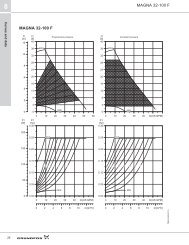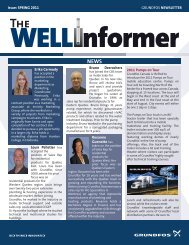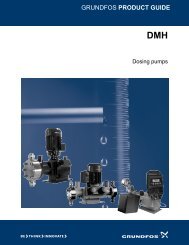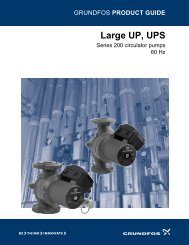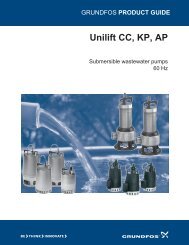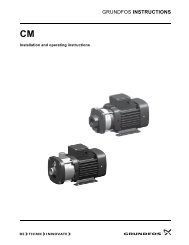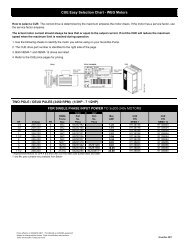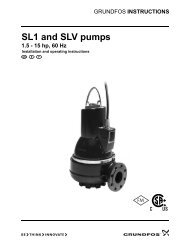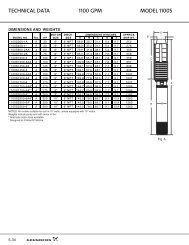You also want an ePaper? Increase the reach of your titles
YUMPU automatically turns print PDFs into web optimized ePapers that Google loves.
<strong>Grundfos</strong> E-<strong>pumps</strong><br />
2<br />
Application examples<br />
As discussed earlier, speed control of <strong>pumps</strong> is an<br />
efficient way of adjusting pump performance to the<br />
system.<br />
In this section, we will discuss the possibilities of<br />
combining speed-controlled <strong>pumps</strong> with PI controllers<br />
and sensors measuring system parameters, such as<br />
pressure, differential pressure and temperature.<br />
On the following pages, the different options will be<br />
presented through examples.<br />
Constant-temperature control<br />
Performance adjustment by means of speed control is<br />
suitable for a number of industrial applications. Figure<br />
14 shows a system with an injection molding machine<br />
which must be water-cooled to ensure high quality<br />
production.<br />
Setpoint t set t set<br />
PI<br />
controller<br />
Actual value t r<br />
Product overview<br />
Constant-pressure control<br />
A pump supplies tap water from a break tank to various<br />
taps in a building.<br />
The demand for tap water varies, and so does the<br />
system characteristic, according to the required flow.<br />
To achieve comfort and energy savings, a constant<br />
supply pressure is recommended.<br />
Cooling<br />
plant<br />
Speed<br />
controller<br />
Temperature<br />
transmitter<br />
Injection molding<br />
machine<br />
h<br />
Setpoint p set set<br />
Break Break tank<br />
tank<br />
PT<br />
Q 1<br />
p 1<br />
H 1<br />
H<br />
n n<br />
n x<br />
p set<br />
h<br />
PI-<br />
controller<br />
Speed<br />
controller<br />
Q 1<br />
Fig. 13 Constant-pressure control<br />
Actual value p 1<br />
Pressure transmitter<br />
transmitter<br />
Q max<br />
As appears from fig. 13, the solution is a speedcontrolled<br />
pump with a PI controller. The PI controller<br />
compares the required pressure, p set , with the actual<br />
supply pressure, p 1 , measured by a pressure<br />
transmitter PT.<br />
If the actual pressure is higher than the setpoint, the<br />
PI controller reduces the speed and consequently the<br />
performance of the pump until p 1 = p set . Figure 13<br />
shows what happens when the flow is reduced from<br />
Q max. to Q 1 .<br />
The controller reduces the speed of the pump from<br />
n n to n x in order to ensure that the required discharge<br />
pressure is p 1 = p set . The pump ensures that the<br />
supply pressure is constant in the flow range of<br />
0 to Q max. . The supply pressure is independent of the<br />
level (h) in the break tank. If h changes, the PI<br />
controller adjusts the speed of the pump so that p 1<br />
always corresponds to the setpoint.<br />
Q<br />
Taps<br />
TM03 0410 5004<br />
Fig. 14 Constant-temperature control<br />
The pump will be operating at a fixed system<br />
characteristic. The controller will ensure that the actual<br />
flow, Q 1 , is sufficient to ensure that t r = t set .<br />
The machine is cooled with water at 59 °F (15 °C) from<br />
a cooling plant. To ensure that the molding machine<br />
runs properly and is cooled sufficiently, the return-pipe<br />
temperature has to be kept at a constant level,<br />
t r = 68 °F (20 °C). The solution is a speed-controlled<br />
pump, controlled by a PI controller. The PI controller<br />
compares the required temperature, t set , with the<br />
actual return-pipe temperature, t r , which is measured<br />
by a temperature transmitter TT. This system has a<br />
fixed system characteristic, and therefore the duty<br />
point of the pump is located on the curve between<br />
Q min and Q max . The higher the heat loss in the<br />
machine, the higher the flow of cooling water needed<br />
to ensure that the return-pipe temperature is kept at a<br />
constant level of 68 °F (20 °C).<br />
TM03 0412 5004<br />
17



